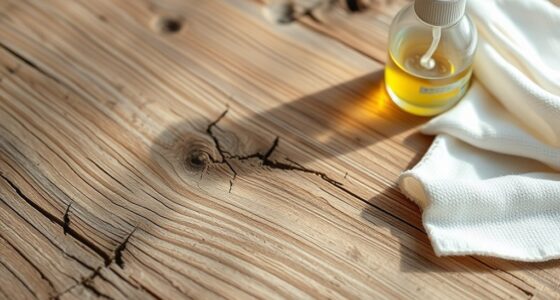Kiln-dried wood is essential because it has a controlled moisture level, making it more stable, durable, and easier to work with. It reduces the risk of warping, cracking, and shrinking, which can compromise your projects. Properly dried wood burns cleaner and more efficiently, saving you energy and maintenance costs. Knowing why kiln-dried wood matters helps guarantee better results and longevity. Keep going to discover how to choose, handle, and store it for the best outcomes.
Key Takeaways
- Kiln drying ensures consistent moisture levels, preventing warping, cracking, and structural issues in wood.
- Proper moisture content improves burning efficiency, producing less smoke, creosote, and cleaner emissions.
- It enhances wood stability and durability, extending the lifespan of furniture, flooring, and other projects.
- Kiln-dried wood maintains natural beauty, uniform color, and grain, ensuring a high-quality aesthetic.
- Controlled drying reduces defects and guarantees even shrinkage, preserving the wood’s structural integrity over time.
Understanding the Kiln-Drying Process
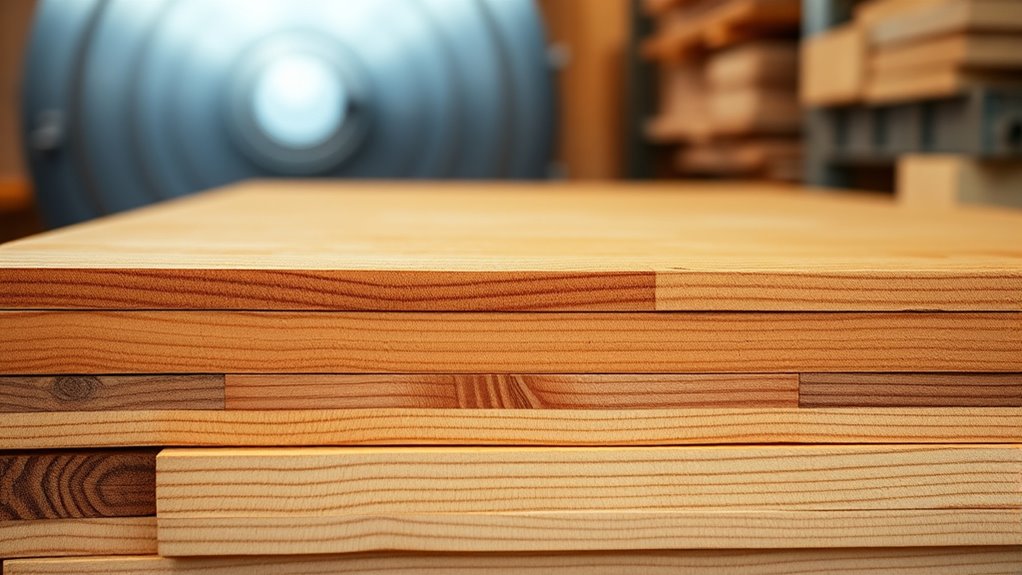
The kiln-drying process involves carefully removing moisture from wood through controlled heat and airflow. This method minimizes wood shrinkage, which can cause warping or cracking if not managed properly. Achieving kiln uniformity is essential, as consistent heat distribution ensures all pieces dry evenly, reducing defects. During drying, you need to monitor temperature and humidity levels precisely to prevent uneven moisture loss. Proper kiln operation guarantees the wood’s dimensions stay stable and predictable. By regulating these factors, you prevent excessive shrinkage and ensure the wood maintains its quality. Additionally, controlled drying conditions are key to producing high-quality kiln-dried wood that meets strict standards for stability and durability. Understanding this process helps you appreciate how kiln-dried wood offers superior stability and durability compared to air-dried options, making it an ideal choice for precise woodworking projects or construction.
The Importance of Moisture Content in Wood

Maintaining the right moisture content in wood is essential for ensuring its stability and performance in your projects. If the moisture levels are too high, the wood can warp, crack, or shrink over time, compromising your results. Conversely, overly dry wood becomes brittle and more prone to splitting. Proper drying methods, like kiln-drying, help regulate moisture content, bringing it to suitable levels for use. Knowing the moisture content ensures the wood remains stable during installation and use. You should always check moisture levels before working with wood, especially when precision matters. Kiln-dried wood offers consistent moisture content, reducing the risk of problems caused by fluctuating humidity. In short, controlling moisture content through effective drying methods is key to achieving durable, high-quality craftsmanship. Proper drying techniques are crucial for maintaining consistent moisture levels and preventing future issues.
How Kiln-Dried Wood Prevents Warping and Cracking
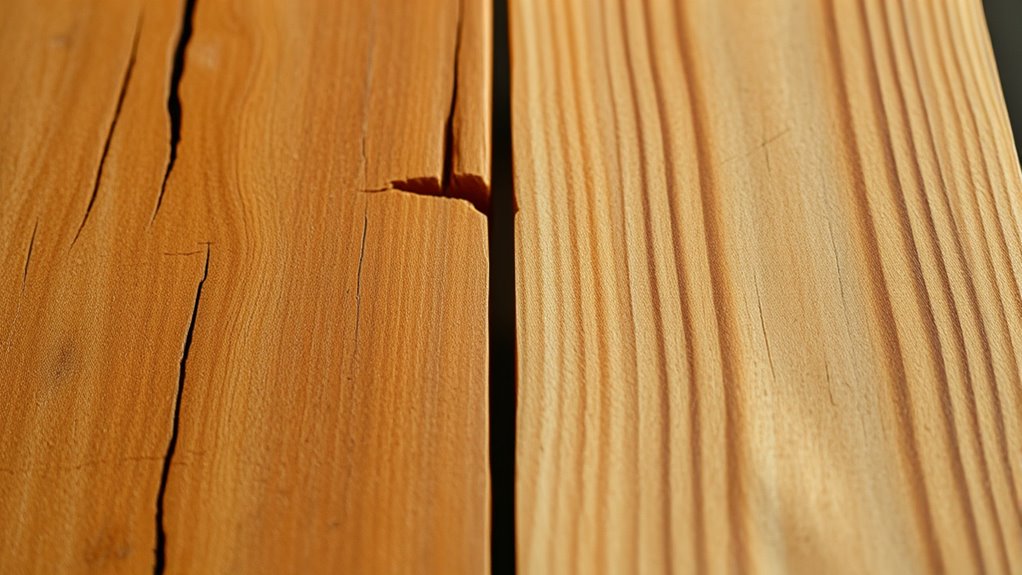
Since moisture imbalance is a primary cause of warping and cracking, kiln-dried wood helps prevent these issues by reducing variability in moisture levels. When the wood’s moisture content is stable, it resists changes that cause distortion over time. Additionally, kiln drying enhances the grain pattern and ensures color consistency, giving your project a uniform appearance. Properly dried wood also shrinks evenly, minimizing the risk of cracks. The process of sound healing is believed to influence cellular regeneration, which parallels how properly dried wood maintains its integrity over time. Here’s how it benefits you:
| Benefit | Effect | Result |
|---|---|---|
| Reduced moisture | Prevents uneven shrinkage | Less warping and cracking |
| Uniform grain | Improves appearance | Aesthetic consistency |
| Consistent color | Maintains visual appeal | Professional finish |
| Stability | Enhances durability | Longer-lasting projects |
Enhancing the Stability and Durability of Your Projects

To guarantee your projects stand the test of time, focusing on the stability and durability of the wood you choose is essential. Kiln-dried wood offers better stability by reducing internal moisture, which minimizes movement over time. Pay attention to grain patterns, as consistent and attractive grains contribute to both strength and visual appeal. Uniform grain patterns help prevent weaknesses and cracking, ensuring your project remains solid. Additionally, kiln-dried wood maintains color consistency, giving your finished piece a professional look and reducing the risk of unsightly discoloration. This uniformity makes finishing easier and results in a more durable, long-lasting product. Properly stored bicycle tires can also last 3-5 years in optimal conditions, further ensuring your projects and equipment remain reliable. By selecting kiln-dried wood, you enhance both the structural integrity and aesthetic quality of your projects, leading to better results that last.
Reducing the Risk of Mold and Fungal Growth
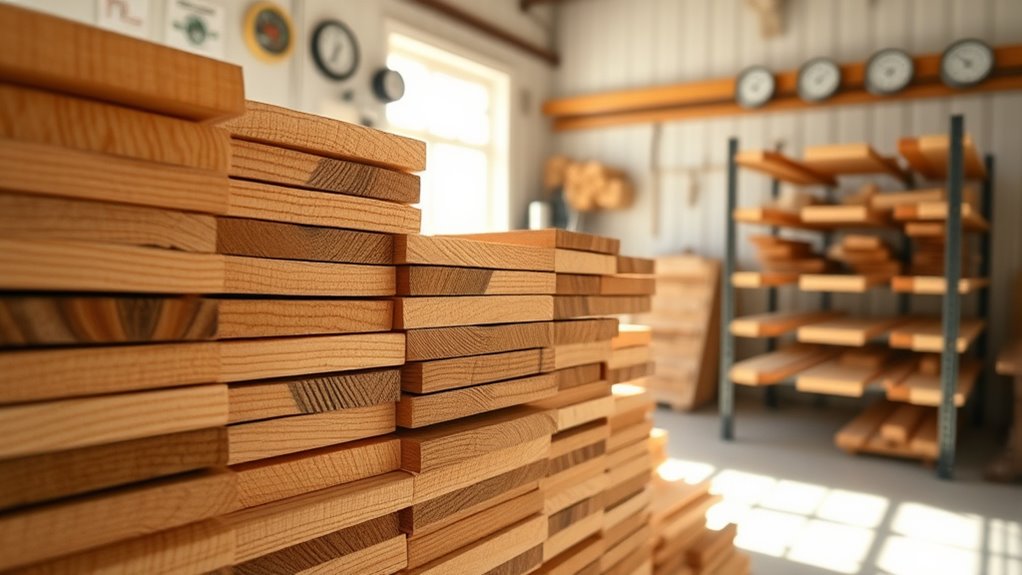
Choosing kiln-dried wood not only improves stability and durability but also helps prevent mold and fungal growth. By reducing moisture content, kiln drying minimizes the environment that fungi need to thrive, enhancing mold prevention. Less moisture means fewer opportunities for mold spores to settle and grow, which is especially important in humid or damp settings. Additionally, kiln drying increases the wood’s fungal resistance, making it less susceptible to decay caused by fungi. When you select kiln-dried wood, you’re proactively reducing the risk of mold-related issues, which can compromise your project’s integrity and safety. Properly dried wood creates a less hospitable environment for mold and fungi, saving you time and money on repairs or replacements later.
Improving Workability and Finish Quality

Kiln-dried wood considerably enhances workability and finish quality by reducing moisture content, making it easier to cut, shape, and join. This lower moisture level promotes better grain consistency, resulting in fewer splinters and more predictable carving or planing. The improved surface smoothness allows you to achieve a cleaner, more professional finish without extra sanding or smoothing. Since kiln-dried wood shrinks less during use, your projects stay true to size and shape, reducing gaps and misalignments. The consistent moisture content also helps prevent warping or cracking that can compromise the final look. Additionally, understanding ethical hacking techniques can help you better secure your projects against vulnerabilities. Overall, kiln-dried wood provides a more reliable, easier working material, ensuring your craftsmanship looks polished and refined every time.
Comparing Kiln-Dried and Air-Dried Wood
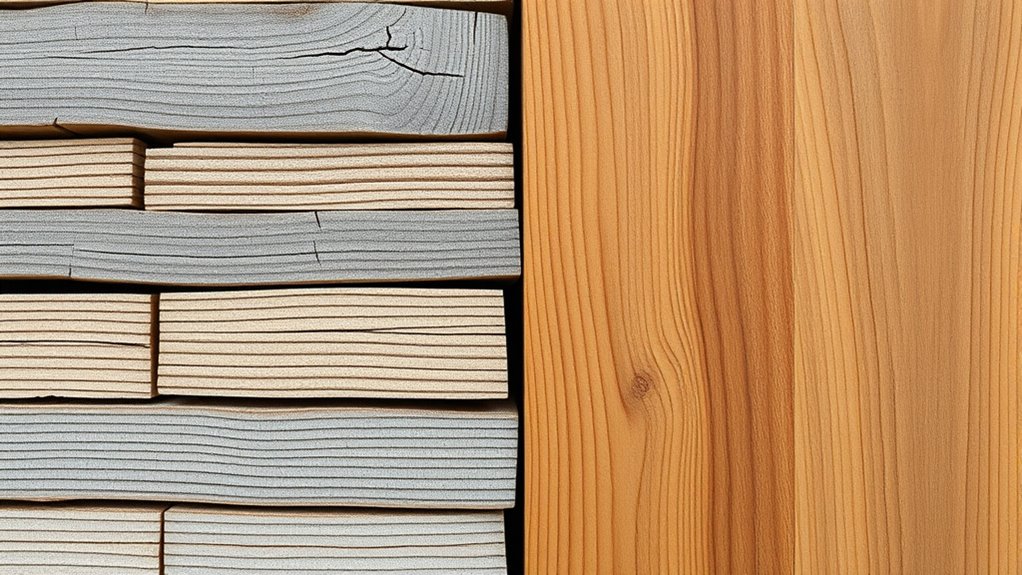
You’ll notice that kiln-dried wood has a much lower moisture content than air-dried wood, which affects how it burns and handles. This difference means kiln-dried options burn more efficiently and produce less smoke and soot. Understanding these distinctions helps you choose the right type for your project or stove.
Moisture Content Differences
While both kiln-dried and air-dried wood ultimately reach a low moisture content, they do so through different processes that considerably affect their final levels. Moisture measurement is key to understanding these differences. Kiln drying uses controlled heat and humidity, speeding up wood seasoning and consistently reducing moisture content to around 6-8%. Air-dried wood relies on natural evaporation over months, resulting in a broader moisture range, often 12-20%. Because kiln drying precisely controls temperature and humidity, you get a more uniform moisture level, which minimizes issues like warping or splitting. In contrast, air-dried wood can have uneven moisture distribution, especially if humidity fluctuates. This variability impacts how well the wood performs in your projects, making kiln-dried options more reliable for consistent moisture content.
Burning Efficiency and Cleanliness
Ever wondered which type of wood burns more efficiently and cleanly? Kiln-dried wood generally outperforms air-dried wood because of superior wood seasoning and moisture control. With lower moisture content, kiln-dried wood ignites faster and produces more heat, reducing smoke and creosote buildup. It also burns more completely, meaning less ash and cleaner chimneys. Properly dried kiln wood guarantees consistent burning, better heat output, and fewer emissions. moisture content plays a crucial role in how efficiently and cleanly the wood burns.
Selecting the Right Wood for Your Specific Needs
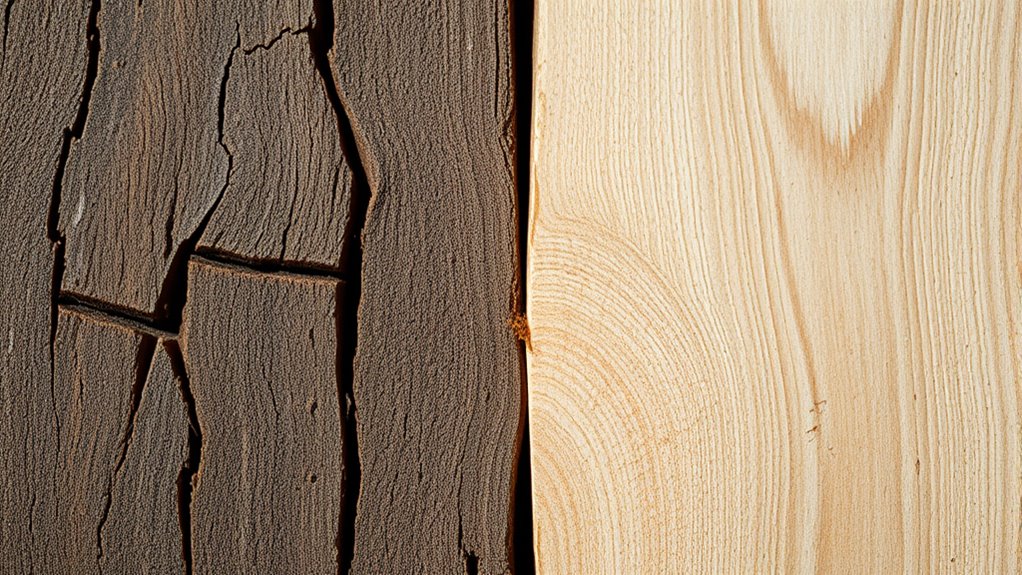
Choosing the right kiln-dried wood depends on understanding your specific project requirements and the properties of different wood types. Consider the wood grain, which affects strength and appearance, and color consistency, important for visual harmony. For example, hardwoods like oak have prominent grain patterns and uniform color, ideal for furniture. Softer woods like pine may have varied grains and color, suited for rustic projects. Use this table to guide your choice:
| Wood Type | Best Use | Key Traits |
|---|---|---|
| Oak | Fine furniture | Prominent grain, consistent color |
| Maple | Cutting boards | Smooth grain, light color |
| Pine | Decorative accents | Soft, varied grain, light hue |
Matching these traits to your project ensures your finished piece looks great and performs well. Additionally, considering wood stability can help prevent warping or cracking over time.
Tips for Properly Handling and Storing Kiln-Dried Wood
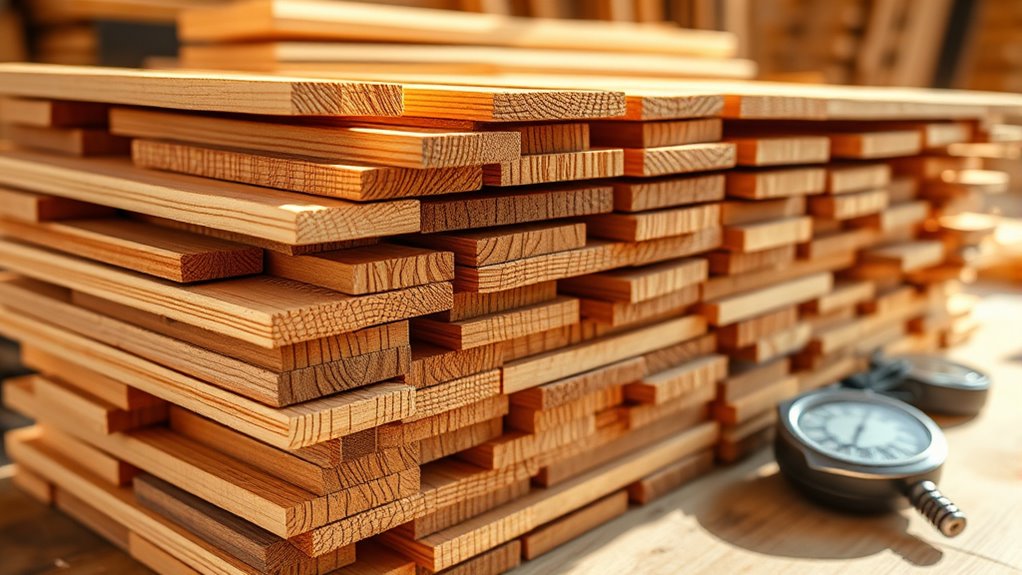
Proper handling and storage are essential to maintain the quality of kiln-dried wood after purchase. To preserve its wood aesthetics and maximize kiln benefits, keep the wood in a dry, well-ventilated area away from direct sunlight. Stack the wood properly to prevent warping and ensure airflow. Cover it loosely with a breathable tarp or cloth to protect it from dust and moisture without trapping humidity. Avoid stacking wet or damp wood, which can compromise its dryness and appearance. Also, handle the wood carefully to prevent dents or scratches that could affect its finish. Additionally, using proper storage techniques helps prolong the lifespan of kiln-dried wood and keeps it in optimal condition. By following these tips, you’ll keep your kiln-dried wood in prime condition for your projects, ensuring it retains its beauty and structural integrity.
Frequently Asked Questions
How Does Kiln-Drying Affect the Environmental Impact of Wood Production?
Kiln-drying impacts the environmental footprint of wood production by promoting sustainable sourcing. It reduces moisture content, making wood more efficient to use and less prone to decay or pests, which cuts down on waste. This process also lowers the carbon footprint because it minimizes energy consumption during storage and transportation. By choosing kiln-dried wood, you support eco-friendly practices and help lessen overall environmental impacts associated with wood products.
Can Kiln-Dried Wood Be Recycled or Repurposed Easily?
You can recycle or repurpose kiln-dried wood, but recycling challenges may arise due to treatments or finishes applied during drying. Creative repurposing is common, such as turning old wood into furniture, art, or garden projects. Kiln-dried wood’s stability makes it easier to work with for DIY projects, but verify it’s free of harmful chemicals. Overall, with some effort, kiln-dried wood can be effectively reused and given new life.
Is Kiln-Dried Wood Suitable for Outdoor or Exposed Use?
You can use kiln-dried wood outdoors, but it’s essential to take into account weather resistance and durability factors. Kiln-dried wood typically has less moisture, making it less prone to warping or rotting when exposed to the elements. However, applying sealants or finishes enhances its weather resistance, ensuring it withstands rain, sun, and humidity better. Proper maintenance extends its longevity, making kiln-dried wood a practical choice for outdoor or exposed projects.
How Does Kiln-Drying Influence the Aesthetic Qualities of the Wood?
When you choose kiln-dried wood, you notice improved aesthetic qualities like enhanced color and more uniform grain. The drying process reduces moisture, preventing warping and cracking, which helps the wood maintain a consistent appearance. You’ll see a richer, more vibrant hue and smoother surface, making your projects look polished and professional. Overall, kiln-drying elevates the visual appeal by emphasizing grain uniformity and deepening color, giving your wood a refined look.
Are There Any Health Considerations When Working With Kiln-Dried Wood?
When working with kiln-dried wood, you should consider health safety and allergen risk. The drying process reduces moisture and mold, lowering potential allergens. However, fine dust from cutting or sanding can pose inhalation risks, so always wear a mask and work in a well-ventilated area. Proper handling minimizes health concerns, making kiln-dried wood safer and more comfortable to work with overall.
Conclusion
Choosing kiln-dried wood is like revealing the secret to flawless, long-lasting projects. It’s the ultimate game-changer that prevents warping, cracks, and mold—saving you from endless headaches. With kiln-dried wood, you’ll craft masterpieces that stand the test of time, looking better and working easier than ever before. Don’t settle for anything less—trust in kiln-dried wood and turn your woodworking dreams into unstoppable reality!


